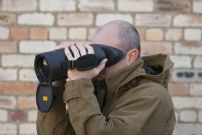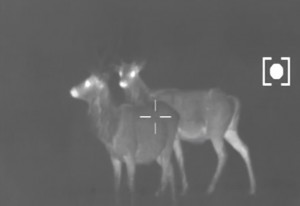 A thermal imager is the ideal companion for wildlife observation, foxing at night, or for wildlife surveys.
A thermal imager is the ideal companion for wildlife observation, foxing at night, or for wildlife surveys.
Picture a wildlife cameraman on a remote woodland area at night, looking to spot a fox on a ridge which he can hear calling. With a traditional night vision device, at range he will only know the fox is there if he happens to pick up eye shine, so in fact could spend a long time scanning the ridge to try and pic out a shadowy shape against the background.
With a thermal imager, you can instantly scan the field and see any heat source whether it be a rabbit, a fox, or a vehicle.
Adding a hand held thermal imager to your equipment portfolio not only saves time in the field, but will bring a whole new perspective to watching wildlife at night.
Mike Powell from Sporting Rifle summed this up perfectly “Out foxing at night i could hear a fox calling yet i couldnt see anything apart from some rabbits in the valley when viewing through my Archer, turning on the Pulsar Quantum Thermal HD38S i was surprised to see two foxes a hundred yards in front of me, that i didnt even know where there!”
How does a Thermal Imager work?
 A thermal imager consists of a germanium lens, microbolometer detector and an electronic processing system.T
A thermal imager consists of a germanium lens, microbolometer detector and an electronic processing system.T
The germanium lens focuses infrared light which is emitted by objects in the field of view, whether it be an animal, a human hiding in bushes, or a vehicle with an engine and exhaust heat signature.
This focused light is then scanned by the microbolometer and the varying heat levels detected change its electrical resistance, which is then interpolated into a signal measured and processed into an image which appears on the OLED screen.
Whether you are looking to check the heat loss from a vehicle roof, or track the movements of a fox moving across a valley, the thermal imager will detect the infrared heat source and transmit it to your eye as a viewed image.
Thermal Imager vs Traditional Night Vision
In completely dark conditions a traditional night vision device relies on a infrared LED light source to illuminate a subject, whether it be from moonlight or a infrared flashlight such as the Nightmaster NM800.
Traditional night vision devices, although operating in infrared, have a red glow from the emitters, and in the case of the Nite Site Spotter, the IR array is so powerful it can often be seen clearly by animals in front of the device.
The thermal imager however can detect heat sources from extreme distance, or from close up, and allow you to view wildlife without being undetected, which is also ideal for covert surveillance.
Traditional night vision is of course less expensive than thermal imagers, however if you compare the Pulsar Quantum HD38S with a detection range of 900m, costing £2899, with a Gen 3 Starlight Archer with a detection range of 400m costing £2499.99, then you can see the difference in price is becoming less significant.
This article comes from scottcountry edit released